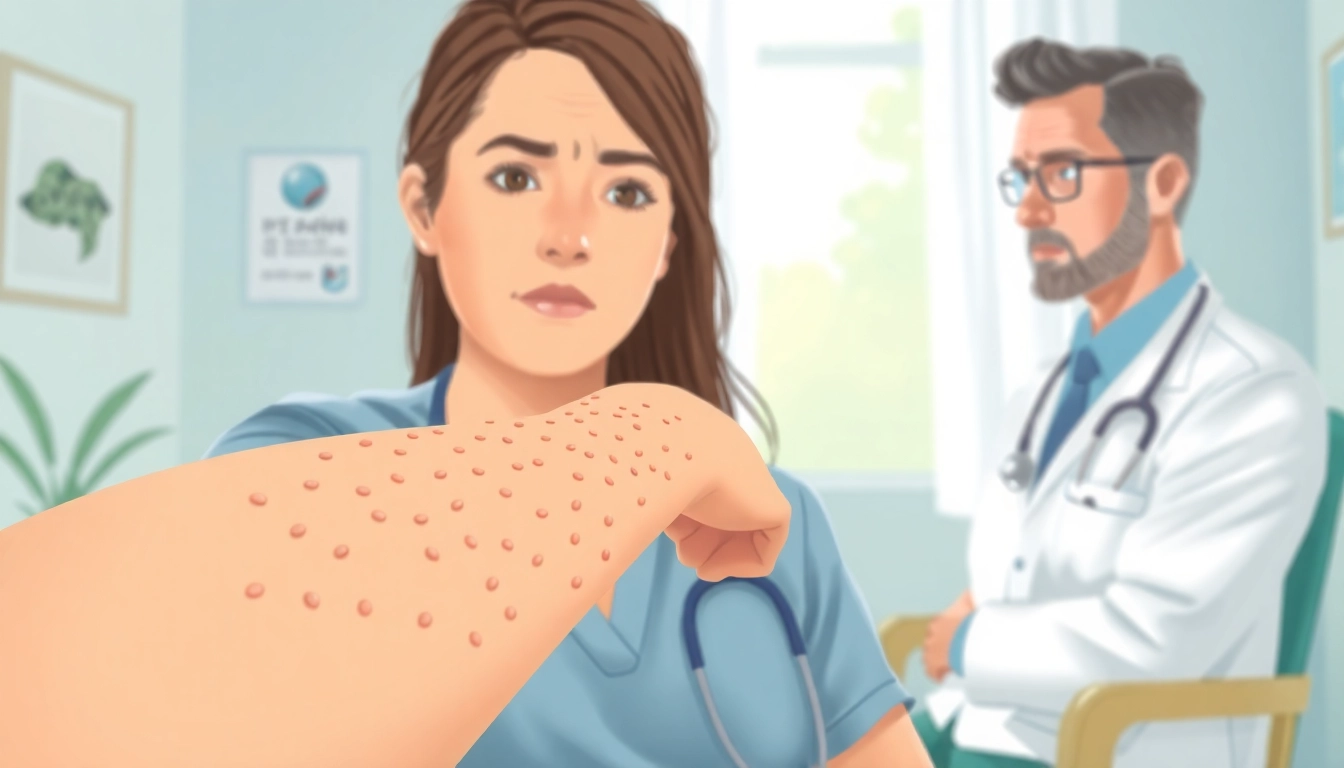What is Chronic Spontaneous Urticaria?
Defining Chronic Spontaneous Urticaria
Chronic spontaneous urticaria (CSU) is a skin condition characterized by recurrent episodes of hives (urticaria) lasting for six weeks or more. This disorder manifests as itchy, raised welts, often referred to as wheals, which can appear suddenly and may vary in size. Unlike acute urticaria, which typically resolves quickly and can be linked to specific allergens or triggers, chronic spontaneous urticaria occurs without an identifiable trigger and can significantly impact the quality of life. Individuals with this condition may experience flares on a daily basis, and the hives can persist for months or even years without a clear cause. For those seeking more information about managing this condition, resources are available that delve into the intricacies of Chronic Spontaneous Urticaria.
Common Symptoms of Chronic Spontaneous Urticaria
The hallmark symptoms of chronic spontaneous urticaria include:
- Persistent Hives: These typically appear as red or skin-colored welts that may vary in size and can migrate during outbreaks.
- Intense Itching: The itch associated with CSU can be persistent and highly uncomfortable, leading to significant distress.
- Angioedema: Some individuals may also experience swelling beneath the skin, particularly around the eyes and lips.
- Fluctuating Symptoms: Symptoms may go through periods of exacerbation and remission, making management challenging.
These symptoms can often interfere with daily activities, sleep, and overall quality of life. Therefore, understanding and effectively managing CSU is crucial for those affected.
How it Differs from Acute Urticaria
The primary distinction between chronic and acute urticaria lies in the duration and the underlying causes. Acute urticaria is classified as hives that last less than six weeks and is usually instigated by identifiable factors, such as food allergies, medications, or insect bites. In contrast, chronic spontaneous urticaria persists for six weeks or more and often remains idiopathic (of unknown origin). While acute cases might resolve with the removal of the triggering allergen, chronic spontaneous urticaria requires a more extensive approach to management, often involving ongoing treatment strategies without a clear resolution.
Causes and Triggers of Chronic Spontaneous Urticaria
Identifying Common Triggers
While the precise cause of chronic spontaneous urticaria remains elusive for many, several known triggers can exacerbate symptoms. Common triggers include:
- Stress: Psychological stress can provoke a flare-up in symptoms for many individuals, illustrating the mind-skin connection.
- Temperature Changes: Heat, cold, and sweating might stimulate hives in sensitive individuals.
- Physical Stimuli: Pressure on the skin from tight clothing or prolonged sitting may lead to urticarial episodes.
- Alcohol Consumption: Alcohol can dilate blood vessels and provoke itchiness, leading to hives.
- Certain Foods: While not as common in chronic cases, some individuals might still react to specific food substances.
Recognizing these triggers is crucial for effective management and avoidance strategies, as individual responses can vary significantly.
Underlying Health Conditions Linked to Urticaria
Several underlying health conditions have been linked to chronic spontaneous urticaria, which may include autoimmune disorders, chronic infections, or thyroid dysfunction. Conditions such as lupus or rheumatoid arthritis can present with overlapping symptoms and could compound the challenges in managing CSU. Additionally, a subset of patients may have an autoimmune component where the body mistakenly targets its own mast cells, leading to the release of histamine and other inflammatory mediators.
Immunological Aspects of Chronic Spontaneous Urticaria
In many cases, chronic spontaneous urticaria is associated with an abnormal immune response. Mast cells, which play an integral role in allergic reactions, release histamine and other substances that cause inflammation and vasodilation, leading to the characteristic wheals and itch. Research indicates that in patients with CSU, there may be a higher prevalence of autoantibodies that activate these mast cells independently of allergens, resulting in the spontaneous appearance of hives. Understanding these immunological mechanisms is critical for both diagnosis and targeted treatment options.
Diagnosing Chronic Spontaneous Urticaria
Common Diagnostic Tests
Diagnosis of chronic spontaneous urticaria typically involves a detailed clinical history and physical examination. In addition, certain tests may be conducted to rule out other conditions or underlying causes:
- Blood Tests: These can check for thyroid function and markers of autoimmune diseases.
- Skin Tests: Sometimes used to identify potential allergens in acute cases but generally less useful in CSU.
- Mast Cell Testing: In specific instances, a test may be performed to check for abnormalities in mast cell activity.
Each of these tests plays a role in comprehensively evaluating the patient’s condition and guiding subsequent treatment.
Working with Healthcare Providers
Collaboration with healthcare professionals is vital for proper diagnosis and management. Patients should provide detailed histories regarding their symptoms, lifestyle, and any possible triggers they have identified. This information helps healthcare providers develop a tailored treatment plan that addresses the individual patient’s needs.
Importance of Patient History
A comprehensive patient history is pivotal in diagnosing chronic spontaneous urticaria. This includes previous allergic reactions, family history of atopic diseases, and lifestyle factors. Detailed symptom diaries can also provide insights into potential triggers and patterns related to symptom onset, aiding in the overall management plan.
Treatment Options for Chronic Spontaneous Urticaria
Medications: Antihistamines and Beyond
Management of chronic spontaneous urticaria primarily involves the use of antihistamines, which alleviate the itch and reduce the severity of hives. Common medications include:
- Second-Generation Antihistamines: These are typically preferred due to their lower sedation risk and improved efficacy.
- Higher-than-Standard Doses: In some cases, increasing the dosage of antihistamines may be necessary to achieve symptom control.
- Other Medications: In refractory cases, other treatments such as corticosteroids, omalizumab (a monoclonal antibody), or cyclosporine may be considered under a healthcare provider’s supervision.
Personalized treatment strategies based on symptom severity and patient response can lead to better long-term outcomes.
Lifestyle Changes that Help Manage Symptoms
In addition to pharmacological treatments, lifestyle modifications can significantly aid in managing chronic spontaneous urticaria. Some strategies include:
- Stress Management: Techniques such as mindfulness, yoga, and meditation can help reduce the impact of stressors.
- Skin Care: Using gentle, fragrance-free skincare products can minimize irritation and allergic responses.
- Dietary Considerations: While food allergens may only be a trigger for some, maintaining a balanced diet and avoiding known triggers can support overall health.
- Regular Physical Activity: Engaging in regular exercise can improve overall well-being and reduce stress.
Implementing these lifestyle changes alongside medical treatment can create a holistic approach to managing chronic spontaneous urticaria.
Complementary and Alternative Therapies
Some patients find relief through complementary therapies. While scientific evidence may vary, modalities such as acupuncture, herbal treatments, and dietary supplements are explored by many as adjuncts to conventional care. However, it is necessary to discuss these options with healthcare providers prior to initiation, as interactions with conventional medications can occur.
Living with Chronic Spontaneous Urticaria
Tips for Daily Management
Living with chronic spontaneous urticaria can be challenging, but several strategies can help individuals manage their condition effectively:
- Keep a Symptom Journal: Tracking symptoms, potential triggers, and response to treatments can provide valuable insights.
- Educate Yourself: Understanding the condition can empower patients and enable better management decisions.
- Stay in Touch with Healthcare Providers: Regular follow-ups can help assess treatment efficacy and adjust protocols as necessary.
- Plan Ahead: Being prepared for potential triggers, such as environmental changes, helps in managing symptoms proactively.
Adopting these tips can lead to improved symptom control and overall well-being.
Emotional and Psychological Support
Chronic spontaneous urticaria can take a toll on mental health. As such, seeking emotional and psychological support is equally important. Support groups, counseling, or therapy can provide a space for individuals to share experiences, coping strategies, and encouragement. Understanding that one is not alone in this journey can significantly help in managing both the emotional and physical aspects of the condition.
Resources and Support Networks for Patients
Numerous resources exist for individuals living with chronic spontaneous urticaria. Patient advocacy groups, online forums, and local health organizations can provide support, information on treatment options, and connections to other patients. Engaging with these resources fosters community and can lead to more effective management strategies through shared experiences.



